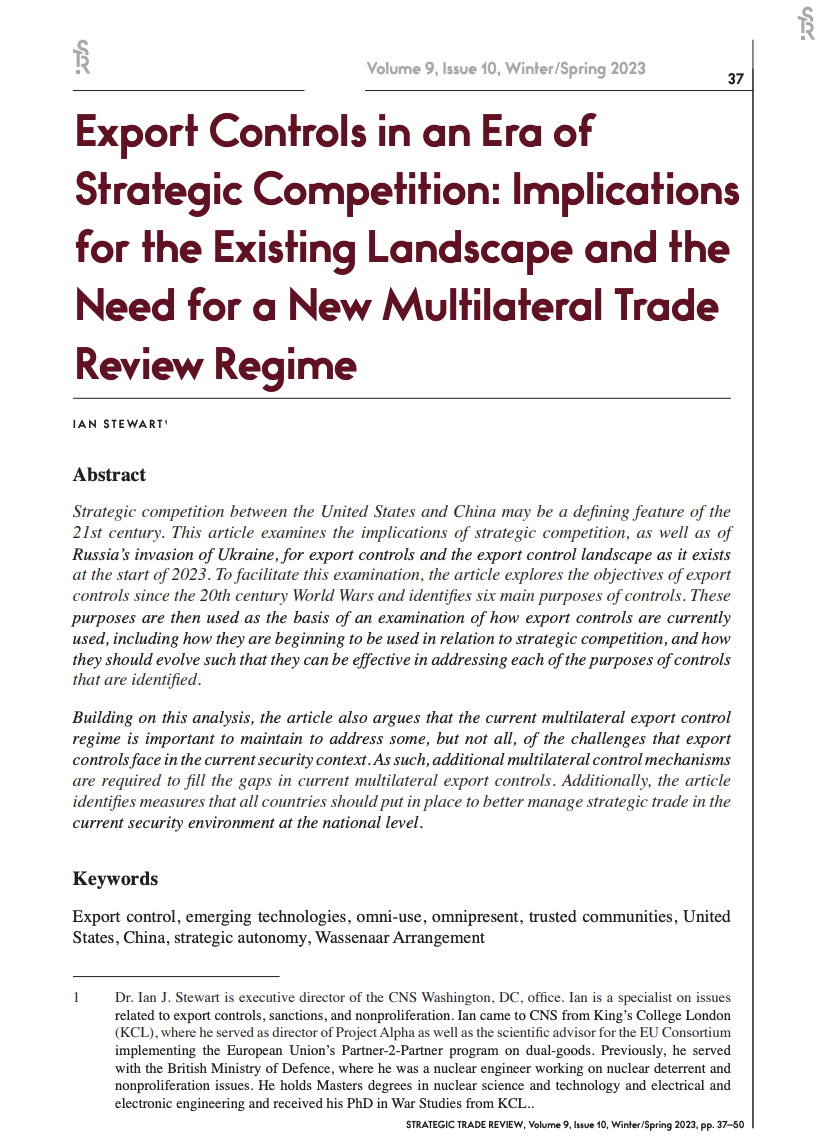The following is an excerpt from the article, available in full at the Strategic Trade Review.
The export control landscape is currently tumultuous. The main multilateral export control regimes largely stagnated during the COVID-19 period because of the difficulty of meeting in person. In parallel, the world has changed as Russia’s invasion of Ukraine makes plain. Overnight, novel export control measures were leveraged against Russia as a form of sanction to choke the Russian defense complex.[1] But it is not only in relation to Russia that the landscape has changed. The rise of a geostrategically competitive China has resulted in the United States taking significant action to curb exports of strategic goods to China that could be used by its military and strategic programs. U.S. measures have recently been implemented that extend even to safeguarding technical leadership vis-à-vis China in fields like semiconductors, as new controls announced on October 7, 2022 demonstrate.[2]
In parallel, evidence has come to light of both Russia and China’s reliance on U.S. or Western goods, software, and technology. Research has shown that Russia’s missiles largely use Western-origin electronics. China’s hypersonic missile program has benefited from U.S. and Western origin software.[3] These specific cases are likely to be the tip of the iceberg; the nature of globalized supply chains means that both Russia and China’s military and strategic sectors are deeply reliant on and well-fed by Western supply chains despite the best efforts of the export control community. Additionally, cyber intrusion has emerged as a prevailing threat to export controls through the theft of export-controlled technology, with both Russia and China being active players in the cyberespionage scene.
Export controls are an important yet understudied instrument of international peace and security. From the 20th century World Wars to the Cold War, from responding to Iraq’s Weapons of Mass Destruction (WMD) program to preventing terrorists from obtaining nuclear weapons, and from responding to Russia’s invasion of Ukraine to responding to China’s rise as a rival of the United States, export controls have been a go-to tool for policymakers. Indeed, the most recent U.S. National Security Strategy issued in October 2022 makes repeated mention of the role and importance of export controls.[4] It is not only the United States that has increased reliance on export controls, but also China. China adopted its first criminal export control law in 2021 and has launched new initiatives at the United Nations concerning export controls.[5] These initiatives, which are examined in this article, are Chinese counter initiatives to U.S. export controls which it feels are directed against it in an era of strategic competition.
In this context, there is a need for a holistic analysis of how the export control landscape is affected by these developments and how export controls should evolve. Are the existing export control regimes capable of coordinating controls to address the current perceived security challenges or are new regimes required? Are new or additional measures required at the national
level, and if so, what should they be? What should controls on so-called emerging technologies look like and how should they be coordinated internationally? There are several academic and practitioner-orientated articles focused on these questions. In relation to emerging technologies, several articles and reports have focused on the type of export controls that should be controlled and how these controls could operate in practice; other literature has sought to examine the challenges associated with subjecting emerging technologies to export controls; other literature again has examined the ability of the multilateral export control regimes to evolve to meet current security challenges, concluding that the nature of these regimes, including their informal, consensus-driven nature, together with a lack of high-level political support, limits their ability to respond to current security challenges; other still have focused on examining the nature of emerging technologies and how trusted communities may be created on a multilateral basis to manage them.[6,7,8,9]
This article seeks to complement existing research by undertaking a holistic analysis of the purposes for which export controls are implemented and examining the extent to which current measures satisfy these purposes. The article is largely an analysis of contemporary issues and secondary sources, but it does benefit from a small number of practitioner interviews and the author’s participation in the open consultations for the United Nations Security Council resolution 1540 Committee’s Comprehensive Review in 2022.
The article first sets out what factors are driving change in the export control landscape at present by examining the purposes for export controls. The article then builds on this to examine the multilateral export control regimes and then, in turn, examines what may need to change at the national level. Finally, consideration is given to how best to coordinate novel controls including on emerging technologies. The paper concludes that the existing export regimes should continue to provide the backbone of multilateral export controls but that new regimes and additional measures at the national level are required for export controls to meet current security challenges.
Read the full article at the Strategic Trade Review. Footnotes are available in the full article.
